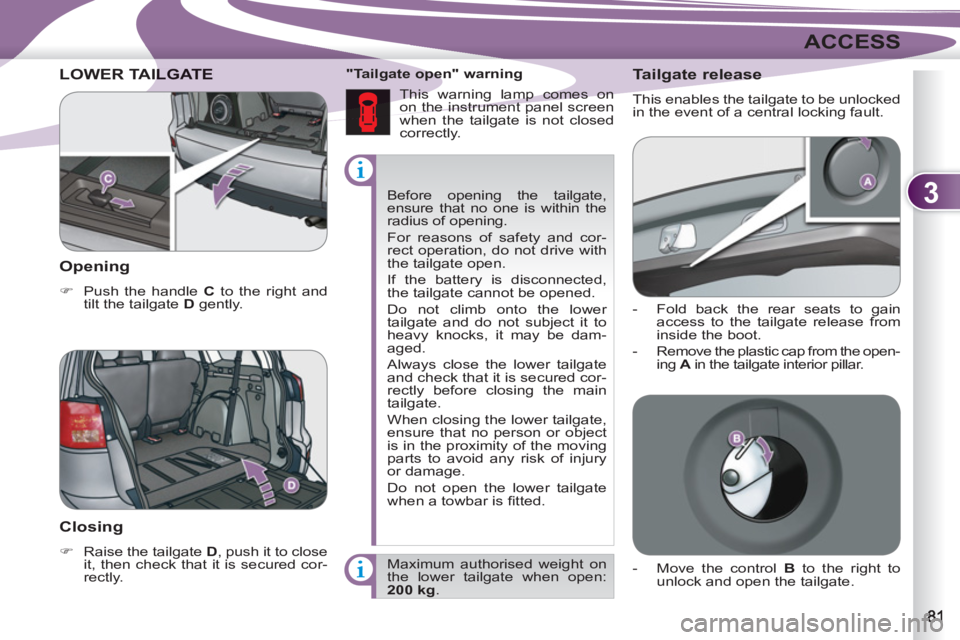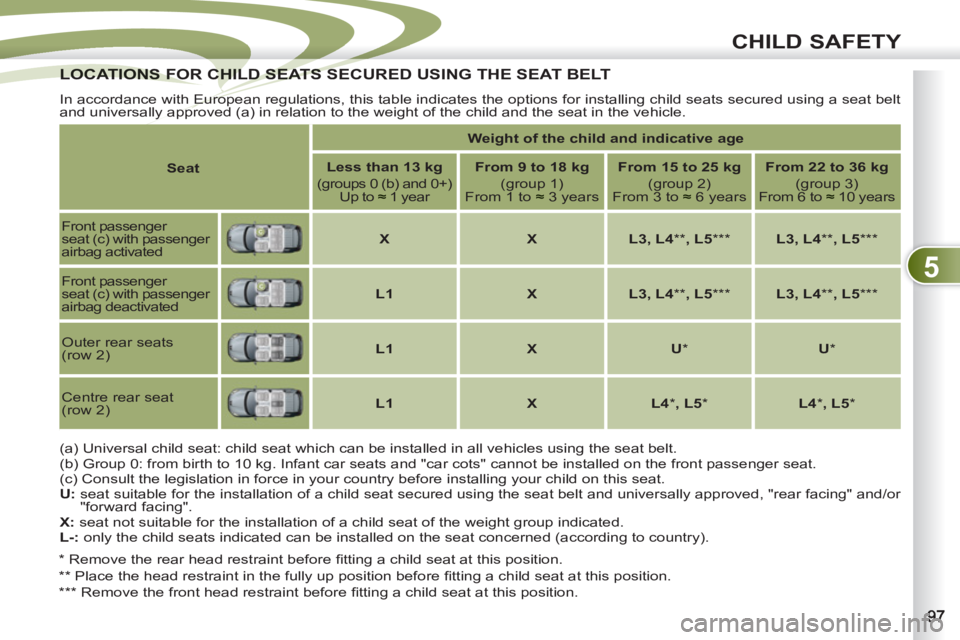Page 55 of 236
2
COMFORT
AR SEATS (ROW 2) REAR SEATS (ROW 2)
Seat back angle adjustment
Pull the control and adjust.
When the seat back is at the correct
angle, release the control.
Sit in the centre of the rear bench seat
to check that the two seats are at the
same level and that the angle of their
seat backs is the same.
Forwards-backwards adjustment
Pull the control towards the outside and
adjust.
When your seat is at the correct dis-
tance, release the control.
To ensure that the seat is secured cor-
rectly, move it forwards and backwards
slightly without using the control. When operating the seats, en-
sure that no person or object
is in the vicinity of the moving
parts to avoid any risk of injury
or damage.
To prevent the seat back from
moving forwards sharply and
knocking you, press on it with
your back or push it with your
hand while operating the lever.
The rear seats can be folded in two
parts (1/3 - 2/3).
Page 56 of 236
2
COMFORT
Rear armrest
Lower the armrest to use it.
To return to the initial confi guration,
push the armrest until it locks in its ver-
tical position.
Access to the third row
The passenger gains access to the
third row of seats by tilting a second
row seat.
To put this seat back in place, refer to
the following pages.
Page 57 of 236
2
COMFORT
Folding the second row *
1.
Raise the rear seat lever A
, or
Pull the button in the boot B
for at least one second, or
Pull the rear seat releasing strap C
towards you.
2.
The seat backs fold forwards then the cushion rises and folds forwards.
3.
After carrying out these operations, press on the seat lightly to check that it is secured correctly. Before folding the seats, lower the head restraints fully.
Before folding the seat backs forwards, insert the seat belt buckles in the slots provided for this purpose in the rear seat
cushion.
Before
folding
the
seats
,
ensure that no object
or person is hindering
the execution of the operations.
Do not place luggage on the folded seats.
*
According to version.
Page 59 of 236
2
COMFORT
"Lowered seats" configuration
1.
Remove the head restraints from the front seats.
2.
Raise the rear armrest and remove the load space cover.
3.
Move the rear seats as far back as possible.
4.
Move the front seats as far forward as possible and tilt their seat backs fully.
5.
Tilt the seat back of the rear seats.
To return the seats to their normal position, carry out these operations in reverse order.
Page 83 of 236

3
ACCESS
Before opening the tailgate,
ensure that no one is within the
radius of opening.
For reasons of safety and cor-
rect operation, do not drive with
the tailgate open.
If the battery is disconnected,
the tailgate cannot be opened.
Do not climb onto the lower
tailgate and do not subject it to
heavy knocks, it may be dam-
aged.
Always close the lower tailgate
and check that it is secured cor-
rectly before closing the main
tailgate.
When closing the lower tailgate,
ensure that no person or object
is in the proximity of the moving
parts to avoid any risk of injury
or damage.
Do not open the lower tailgate
when a towbar is fi tted.
"Tailgate open" warning
This warning lamp comes on
on the instrument panel screen
when the tailgate is not closed
correctly.
LOWER TAILLGATE
Opening
�)
Push the handle C
to the right and
tilt the tailgate D
gently.
Closing
�)
Raise the tailgate D
, push it to close
it, then check that it is secured cor-
rectly. Maximum authorised weight on
the lower tailgate when open:
200 kg
.
Tailgate release
This enables the tailgate to be unlocked
in the event of a central locking fault.
- Fold back the rear seats to gain
access to the tailgate release from
inside the boot.
- Remove the plastic cap from the open-
ing A
in the tailgate interior pillar.
- Move the control B
to the right to
unlock and open the tailgate.
Page 96 of 236

5
CHILD SAFETY
Although one of PEUGEOT's main cri-
teria when designing your vehicle, the
safety of your children also depends on
you.
CHILD SEAT IN THE FE FRONT
*
The rules for carrying children are
specifi c to each country. Refer to the
current legislation in your country.
GENERAL POINTS RELATING
TO CHILD SEATS
"Rearwards-facing"
PEUGEOT recommends
that
children should travel in the rear
seats
of your vehicle:
- "rearwards-facing"
up to
the age of 2,
- "forwards-facing"
over the
age of 2. When a "rearwards-facing" child
seat is installed on the front
passenger seat
, it is essential
that the passenger airbag is de-
activated. Otherwise, the child
would risk being seriously
injured or killed if the airbag
were to infl ate
. When a "forwards-facing" child seat is
installed on the front passenger seat
,
adjust the vehicle's seat to the interme-
diate longitudinal position with the seat
back upright and leave the passenger
airbag activated.
"Forwards-facing"
Intermediate longitudinal position
For maximum safety, please observe
the following recommendations:
- in accordance with European reg-
ulations, all children under the
age of 12 or less than one and a
half metres tall must travel in ap-
proved child seats suited to their
weight
, on seats fi tted with a seat
belt or ISOFIX mountings * ,
- statistically, the safest seats in
your vehicle for carrying children
are the rear seats,
- a child weighing less than 9 kg
must travel in the "rearwards-
facing" position both in the front
and in the rear.
Page 97 of 236
5
CHILD SAFETY
CHILD SEATS RECOMMENDED BY PEUGEOT CHILD SEATS RECOMMENDED B
PEUGEOT offers a complete range of recommended child seats which are secured
using a three point seat belt
:
Group 0+: from birth to 13 kg
L1
"RÖMER Baby-Safe Plus"
Installed in the rearwards-facing position.
Groups 2 and 3: from 15 to 36 kg
L3
"RECARO Start''
L4
"KLIPPAN Optima"
From the age of 6 years
(approximately 22 kg),
the booster is used on its own.
L5
"RÖMER KIDFIX"
Can be fi tted to the vehicle's ISOFIX mountings.
The child is restrained by the seat belt.
Page 99 of 236

5
CHILD SAFETY
LOCATIONS FOR CHILD SEATS SECURED USING THE SEAT BELTLOCATIONS FOR CHILD SEATS S
In accordance with European regulations, this table indicates the options for installing child seats secured using a seat belt
and universally approved (a) in relation to the weight of the child and the seat in the vehicle.
(a) Universal child seat: child seat which can be installed in all vehicles using the seat belt.
(b) Group 0: from birth to 10 kg. Infant car seats and "car cots" cannot be installed on the front passenger seat.
(c) Consult the legislation in force in your country before installing your child on this seat.
U:
seat suitable for the installation of a child seat secured using the seat belt and universally approved, "rear facing" and/or
"forward facing".
X:
seat not suitable for the installation of a child seat of the weight group indicated.
L-:
only the child seats indicated can be installed on the seat concerned (according to country).
Seat
Weight of the child and indicative age
Less than 13 kg
(groups 0 (b) and 0+)
Up to
≈ 1 year
From 9 to 18 kg
(group 1)
From 1 to ≈ 3 years
From 15 to 25 kg
(group 2)
From 3 to ≈ 6 years
From
22 to 36 kg
(group 3)
From 6 to ≈ 10 years
Front passenger
seat (c) with passenger
airbag activated
X
X
L3, L4
**
, L5
***
L3, L4
**
, L5
***
Front passenger
seat (c) with passenger
airbag deactivated
L1
X
L3, L4
**
, L5
***
L3, L4
**
, L5
***
Outer rear seats
(row 2)
L1
X
U
*
U
*
Centre rear seat
(row 2)
L1
X
L4
*
,
L5
*
L4
*
, L5
*
*
Remove the rear head restraint before fi tting a child seat at this position.
**
Place the head restraint in the fully up position before fi tting a child seat at this position.
***
Remove the front head restraint before fi tting a child seat at this position.